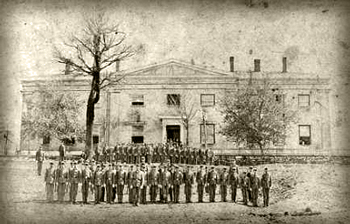By Dr. Sol Taylor
Second of two parts.
"Making Cents"
Saturday, July 18, 2009
| U |
|
nder an act of Congress in 1835, three new mints were to be built to meet the needs of the growing population and the need for more domestic coinage.
The new mints were New Orleans Mint and two smaller gold minting facilities — one at Charlotte, N.C., and the other at Dahlonega, Geo.
During this so-called "hard times" period, more foreign coins were in use in the United States than domestic coinage. Various one cent-sized tokens were in common use — more so than U.S.-minted cents (and half cents). Latin American silver and gold coins met the needs in commerce in the outer reaches of the republic such as Texas, Louisiana, western Georgia, the Carolinas, Ohio, and points farther West.
In the early 1830s, Georgia was experiencing a gold rush — mainly mined gold in the foothills near Dahlonega. The act of 1835 authorized a federal mint to be established at Dahlonega to handle the domestic gold for production of U.S. gold coins.
A steam press and furnace, along with the tools and hardware for a small mint, were ordered, and by 1838 the mint was in operation.
The first coins were $5 gold pieces minted in April 1838. From 1838 to 1861 the mint produced $1, $2½ and $5 gold coins and only in 1854 produced a small number of $3 gold coins (1,120 pieces). Each coin bore the "D" mintmark.
Since 1906 ,the "D" mintmark has been used for coins made at the Denver Mint, which opened long after the Dahlonega Mint closed down.
No copper or silver coins were minted at Dahlonega.
When the Civil War broke out in 1861, the Dahlonega Mint was seized by the South and continued to manufacture coins during 1861. The number of $1 coins is unknown, but today they are considered very rare. No $2½ pieces were made in that year, and only 1,597 $5 coins were minted.
The mint ceased to produce coins later in the year as the source of bullion dried up. These coins are considered rare in all grades.
For most of the years of operation, the Dahlonega Mint produced fewer coins than its sister mint at Charlotte. Both branch mints produced far fewer coins than the Philadelphia Mint. The total output from 1838 to 1861 was over $6 million.
With the California Gold Rush of 1849, a new mint opened in San Francisco in 1854 and gold coins were produced there to meet needs on the West coast. Many types of privately minted gold coins were issued by various assay offices at that time, and they met the needs until federal coinage caught up with the demand.
In 1878 the mint building at Dahlonega was gutted in a fire. It was never rebuilt. Some gold recovered from the wreckage was made into gold leaf and was applied to the Georgia State Capitol dome, where it is referred to today as "under gold dome."
The new mints were New Orleans Mint and two smaller gold minting facilities — one at Charlotte, N.C., and the other at Dahlonega, Geo.
During this so-called "hard times" period, more foreign coins were in use in the United States than domestic coinage. Various one cent-sized tokens were in common use — more so than U.S.-minted cents (and half cents). Latin American silver and gold coins met the needs in commerce in the outer reaches of the republic such as Texas, Louisiana, western Georgia, the Carolinas, Ohio, and points farther West.
In the early 1830s, Georgia was experiencing a gold rush — mainly mined gold in the foothills near Dahlonega. The act of 1835 authorized a federal mint to be established at Dahlonega to handle the domestic gold for production of U.S. gold coins.
A steam press and furnace, along with the tools and hardware for a small mint, were ordered, and by 1838 the mint was in operation.
The first coins were $5 gold pieces minted in April 1838. From 1838 to 1861 the mint produced $1, $2½ and $5 gold coins and only in 1854 produced a small number of $3 gold coins (1,120 pieces). Each coin bore the "D" mintmark.
Since 1906 ,the "D" mintmark has been used for coins made at the Denver Mint, which opened long after the Dahlonega Mint closed down.
No copper or silver coins were minted at Dahlonega.
When the Civil War broke out in 1861, the Dahlonega Mint was seized by the South and continued to manufacture coins during 1861. The number of $1 coins is unknown, but today they are considered very rare. No $2½ pieces were made in that year, and only 1,597 $5 coins were minted.
The mint ceased to produce coins later in the year as the source of bullion dried up. These coins are considered rare in all grades.
For most of the years of operation, the Dahlonega Mint produced fewer coins than its sister mint at Charlotte. Both branch mints produced far fewer coins than the Philadelphia Mint. The total output from 1838 to 1861 was over $6 million.
With the California Gold Rush of 1849, a new mint opened in San Francisco in 1854 and gold coins were produced there to meet needs on the West coast. Many types of privately minted gold coins were issued by various assay offices at that time, and they met the needs until federal coinage caught up with the demand.
In 1878 the mint building at Dahlonega was gutted in a fire. It was never rebuilt. Some gold recovered from the wreckage was made into gold leaf and was applied to the Georgia State Capitol dome, where it is referred to today as "under gold dome."
©2009 SCV COMMUNICATIONS GROUP & SOL TAYLOR · ALL RIGHTS RESERVED.

![[Most Recent Quotes from www.kitco.com]](http://www.kitconet.com/images/quotes_special.gif)

